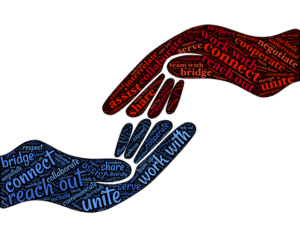
Your Leadership Influence is Urgently Needed: Loneliness as Unhealthy as 15 Cigarettes a Day
Check out this article.
Publication: The Epoch Times
By: Beth Brelje, Reporter
Date: May 18, 2023
Loneliness as Unhealthy as 15 Cigarettes a Day, U.S. Surgeon General Says
Health warnings on cigarette packages started in 1969 after the release of a report from the U.S.
Surgeon General about risks related to smoking. Now the Surgeon General has found something as dangerous as smoking 15 cigarettes a day: loneliness.
The recently released 82-page report “Our Epidemic of Loneliness and Isolation” takes a troubling but hopeful look at who is lonely and why it matters. The report offers recommendations that individuals can try right away, to feel more connected, such as disconnecting from excessive social media use and spending less time in front of screens and more time in front of people. The report pulled information from many studies.
Loneliness is more than just a bad feeling. It harms individual and societal health, the report says. It is associated with a greater risk of cardiovascular disease, dementia, stroke, depression, anxiety, and premature death. The mortality impact of being socially disconnected is similar to smoking up to 15 cigarettes a day and is even greater than obesity and physical inactivity.
Large population studies have documented that, among initially healthy people tracked over time, those who are more socially connected live longer, while those who experience social deficits, including isolation, loneliness, and poor-quality relationships, are more likely to die earlier, regardless of the cause of death, the report said.
“The harmful consequences of a society that lacks social connection can be felt in our schools, workplaces, and civic organizations, where performance, productivity, and engagement are diminished. Given the profound consequences of loneliness and isolation, we have an opportunity, and an obligation, to make the same investments in addressing social connection that we have made in addressing tobacco use, obesity, and the addiction crisis,” Surgeon General Dr. Vivel Murthy wrote in the study’s introduction. He called for building more connected lives in a more connected society.
Failure to connect with others will bring increased risk to personal and collective health, ultimately causing society to splinter and divide until we can no longer stand as a community or a country, Murthy said.

Most at Risk for Loneliness
Anyone can experience loneliness and isolation, but some are at higher risk. They are people with poor physical or mental health, those with disabilities, financial insecurity, those who live alone, single parents, and younger and older populations, the report said.
While the highest rates of social isolation are found among older adults, young adults are almost twice as likely to report feeling lonely than those over 65. The rate of loneliness among young adults has increased every year between 1976 and 2019.
Lower-income adults are more likely to be lonely than those with higher incomes. Sixty-three percent of adults who earn less than $50,000 per year are considered lonely, which is 10 percentage points higher than those who earn more than $50,000 per year. Other groups with a heightened risk include individuals from ethnic and racial minority groups, LGBT individuals, rural residents, victims of domestic violence, and those who experience discrimination or marginalization.
Diminishing Traditional Values
Many traditional indicators of community involvement, including religious groups, clubs, and labor unions, show declining trends in the United States since at least the 1970s. According to the study, in 2018, only 16 percent of Americans reported they felt very attached to their local community.
Membership in organizations that have been important pillars of community connection has declined significantly in this time. Research produced by Gallup, Pew Research Center, and the National Opinion Research Center’s General Social Survey shows that since the 1970s, religious preference, affiliation, and participation among U.S. adults have declined. In 2020, just 47 percent of Americans said they belonged to a church, synagogue, or mosque. That is down from 70 percent in 1999. It is the first dip below 50 percent in the history of the survey question.
“Religious or faith-based groups can be a source for regular social contact, serve as a community of support, provide meaning and purpose, create a sense of belonging around shared values and beliefs, and are associated with reduced risk-taking behaviors,” the report said. “As a consequence of this decline in participation, individuals’ health may be undermined in different ways.”
Family size and marriage rates have been in steady decline for decades. The percentage of Americans living alone has also increased from decade to decade. In 1960, single-person households accounted for only 13 percent of all U.S. households, the report says. In 2022, that number more than doubled to 29 percent of all households.
The reasons people remain single, have smaller families, and live alone are varied, but these changes contribute to more social disconnection and fewer supports to draw upon in times of need.
A fraying of the social fabric can be seen more broadly in society, the report says; trust in each other and major institutions is at near historic lows. Polls conducted in 1972 showed that roughly 45 percent of Americans felt they could reliably trust other Americans. That proportion shrank to roughly 30 percent by 2016.
Social Media Makes Us Less Social
Social media does have benefits. It can foster connection by providing opportunities to stay in touch with friends and family, offer support groups and information about social participation for those with disabilities, and creates opportunities to find community.
The benefits are as familiar as the harms listed in the report. Social media displaces in-person engagement, monopolizes our attention, reduces the quality of our interactions, and diminishes our self-esteem. This can lead to greater loneliness, fear of missing out, conflict, and reduced social connection.
For example, frequent phone use during face-to-face interactions between parents and children or between family and friends creates distraction and reduces conversation quality. This lowers self-reported enjoyment of time spent together in person, the report said.
Social media, smartphones, virtual reality, remote work, artificial intelligence, and assistive technologies changed how we live, work, communicate, and socialize.
Nearly all teens and adults under 65—96 to 99 percent—and 75 percent of adults 65 and over, say that they use the internet. Americans spend an average of six hours per day on digital media, and one-in-three U.S. adults 18 and over report that they are online “almost constantly.”
The percentage of teens ages 13 to 17 years who say they are online “almost constantly” has doubled since 2015.
When looking at social media specifically, the percentage of U.S. adults 18 and over who reported using social media increased from 5 percent in 2005 to roughly 80 percent in 2019.
Among teens ages 13 to 17 years, 95 percent report using social media as of 2022, with more than half reporting that it would be hard to quit social media.
Fewer Friends
The number of close friendships has also declined over several decades. Among people not reporting loneliness or social isolation, nearly 90 percent have three or more confidants. Yet, 49
Social connection declined more during the COVID-19 pandemic, with one study finding a 16 percent decrease in network size from June 2019 to June 2020 among participants.
Not only are social networks getting smaller, but levels of social participation are also declining.
Measures of social exposure from 2003-2020 found that social isolation—determined by average time spent alone—increased with the following figures:
- 2003: 285-minutes a day; 142.5-hours a month spent alone.
- 2019: 309-minutes a day; 154.5-hours a month spent alone.
- 2020: 333-minutes a day; 166.5-hours a month spent alone.
It amounts to an increase of 24 hours per month spent alone.
During this time, social participation in various relationships has declined. The amount of time respondents engaged with friends socially in person decreased:
- 2003- 60 minutes a day; 30 hours a month spent with friends.
- 2020- 20 minutes a day; 10 hours a month spent with friends.
That is 20 fewer hours per month engaging with friends. For young people ages 15 to 24, time spent in-person with friends has reduced by nearly 70 percent over almost two decades, from roughly 150 minutes per day in 2003 to 40 minutes per day in 2020.
COVID-19
“Many of us felt lonely or isolated in a way we had never experienced before. We postponed or canceled meaningful life moments and celebrations like birthdays, graduations, and marriages. Children’s education shifted online—and they missed out on the many benefits of interacting with their friends,” the report acknowledged. “Many people lost jobs and homes. We were unable to visit our children, siblings, parents, or grandparents. Many lost loved ones. We experienced feelings of anxiety, stress, fear, sadness, grief, anger, and pain through the loss of these moments, rituals, celebrations, and relationships.”
Frontline workers had different experiences than those who could work from home.
Parents managing their own work and their children’s online school had a different experience than single young people unable to interact in person with friends.
One survey showed that, by April 2021, one in four individuals reported feeling less close to family members compared to the beginning of the pandemic. But at the same time, about one in five said they felt closer to family members. This may mean the pandemic exacerbated existing family dynamics of connection or disconnection, the report said.
People Need People
Social connection is connected to human behavior, such as nutrition, sleep, and physical activity. It is tied to psychological processes such as the sense of meaning, purpose, feelings of stress, safety, or hopefulness.
The report makes five broad recommendations:
1. Strengthen Social Infrastructure in Local Communities: Invest in local institutions that bring people together.
2. Enact Pro-Connection Public Policies: Consider social connection when writing policy.
3. Mobilize the Health Sector: Train healthcare providers and assess patients.
4. Reform digital environments: Establish and implement safety standards and support the development of pro-connection technologies.
5. Deepen our knowledge: Increase public awareness.
The report recommends workplaces put in place policies that protect workers’ ability to nurture their relationships outside work, including respecting boundaries between work and non-work time, supporting caregiving responsibilities, and creating a culture that supports these policies.
Recommendations for parents include investing in their relationship with their child by recognizing that strong, secure attachments are protective and a good foundation for other healthy relationships. And model healthy social connection, including constructive conflict resolution, spending time together, staying in regular contact with extended family, friends, and neighbors; setting time aside for socializing away from technology or social media; and participating in community events.
Recommendations for individuals include minimizing distraction during conversation to increase the quality of the time spent with others. Don’t check your phone during meals with friends, important conversations, and family time. And look for ways to serve and support others, either by helping your family, co-workers, friends, or strangers in your community or by participating in community service.
Reflect on how you approach others in conversation and actions. Ask yourself, how might kindness change this situation? What would it look like to treat others with respect? How can I be of service? How can I reflect my concern for and commitment to others?
This article was originally published HERE.


No Comments